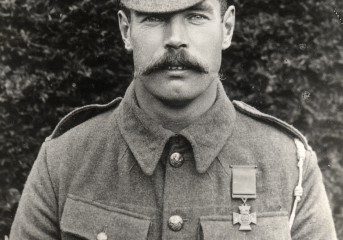HEADGEAR
 Correct method of carrying the Cap, G.S. (General Service)
Correct method of carrying the Cap, G.S. (General Service)
The cap should be folded into a tight roll, with the cap badge displayed, and passed through the left shoulder strap.
The cap, Field Service, is also carried in this manner.
 Correct method of carrying the Steel helmet
Correct method of carrying the Steel helmet
The left arm is passed through the chin-strap, and the helmet drawn up to rest high on the shoulder.
This method replaced the old style of slipping the helmet over the Small Box Respirator Haversac, banned on 1st October 1941, as this damages the haversac and impedes rapid access to the gas mask.
WALKING OUT DRESS
A second set of Battle-Dress may be acquired for best dress if any member so desires. Some soldiers chose to smarten their appearance when off-duty by acquiring, at their own expense, a Field Service Cap, bearing the old style brass Gun cap badge, in khaki, or less commonly, the full colour version.
This latter item was un-official and neither version is to be worn on duty or on parade. These are strictly for off-duty wear with Battle-Dress only.
The last issue of the full-dress ‘blues’ uniform took place, on a very limited scale, in 1936 for the coronation of King George VI. These were not resurrected until well into the 1950’s and are therefore not to be worn.
PERSONAL APPEARANCE
Hair must be kept short, especially at special firings for Veterans and at high profile public shows. Otherwise, period clippers will be used (and I am not qualified to operate these…)
No moustaches, all personnel are to be clean-shaven at all times.
Only period style and original wrist watches will be worn.
GENERAL BEHAVIOUR
All personel are to behanve in a soldierly manner at all times. From the moment you put your uniform on, your are on display.
Within the Battery, always refer to other memebrs by rank – Sargeant, Bombardier, Gunner. Officer and Battery Sergeant-Major to be addressed as Sir.
Watch your language in public.
No standing around with your hands in your pockets.
Always address veterans as SIR.
Stay in character.
Use period slang and expressions – and remember – There’s a war on.


